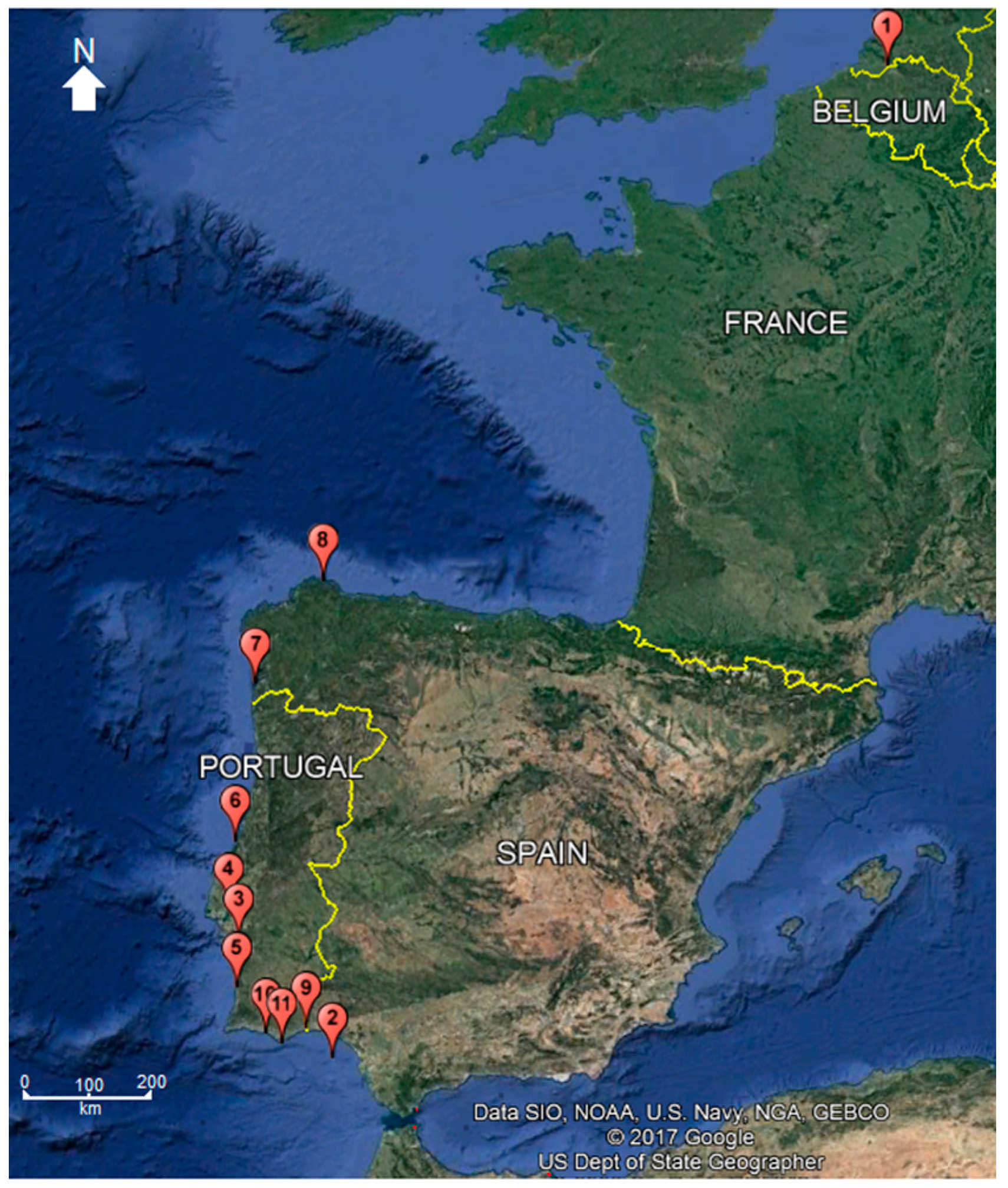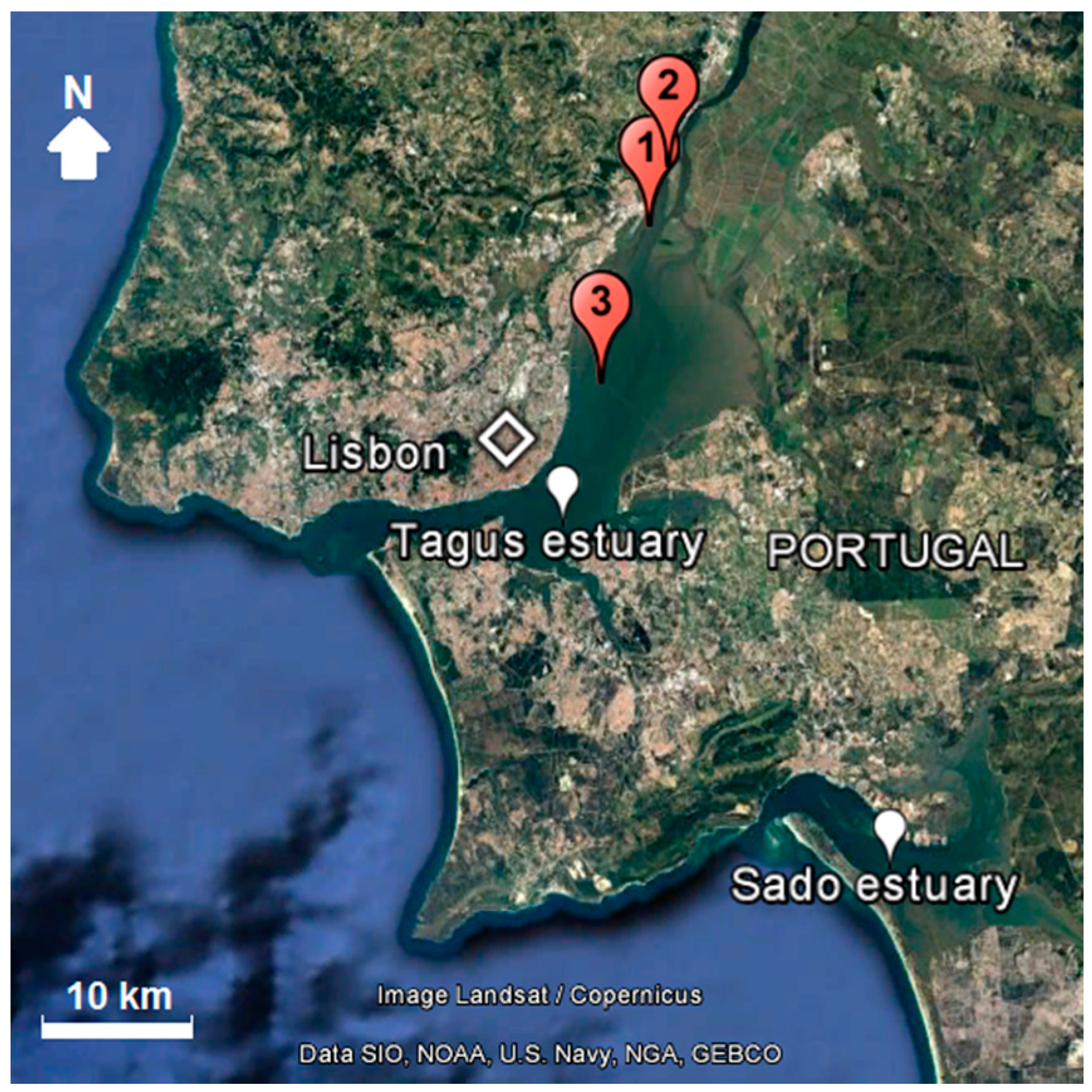An Update on the Invasion of Weakfish Cynoscion regalis (Bloch & Schneider, 1801) (Actinopterygii: Sciaenidae) into Europe
Abstract
:1. Introduction
2. “Single Introduction and Dispersal” vs. “Multiple Independent Introductions”
3. Transforming a Biological Threat into an Economic Opportunity
Acknowledgments
Author Contributions
Conflicts of Interest
References
- Béarez, P.; Gabriel, S.; Dettai, A. Unambiguous identification of the non-indigenous species Cynoscion regalis (Sciaenidae) from Portugal. Cybium 2016, 40, 245–248. [Google Scholar]
- Morais, P.; Teodósio, M.A. The transatlantic introduction of weakfish Cynoscion regalis (Bloch & Schneider, 1801) (Sciaenidae, Pisces) into Europe. Bioinvasions Rec. 2016, 5, 259–265. [Google Scholar]
- A Voz do Algarve: Investigadores do CCMAR Identificam Espécie de Corvina Norte-Americana No Rio Guadiana. Available online: http://www.avozdoalgarve.pt/detalhe.php?id=17032 (accessed on 23 June 2016).
- Corvina norte-americana encontrada no Guadiana. Mundo da Pesca, 2016; 186, 14.
- Bañón, R.; Arias, A.; Arana, D.; Cuesta, J.A. Identification of a non-native Cynoscion species (Perciformes: Sciaenidae) from the Gulf of Cádiz (southwestern Spain) and data on its current status. Sci. Mar. 2017, 181, 19–26. [Google Scholar] [CrossRef]
- Gomes, P.; Vieira, A.R.; Oliveira, R.; Silva, H.; Martins, R.; Carneiro, M. First record of Cynoscion regalis (Pisces, Sciaenidae) in Portuguese continental waters. J. Fish Biol. 2017, 90, 2470–2474. [Google Scholar] [CrossRef] [PubMed]
- Pousão-Ferreira, P.; Instituto Portugês do Mar e da Atmosfera, Olhão, Portugal. Personal communication. 2016. [Google Scholar]
- OsPescas: Douradas e Rainhas Pelo Sado. Available online: http://ospescas.blogspot.pt/2015/09/surfcasting-douradas-e-rainhas-pelo-sado.html (accessed on 25 February 2015).
- OsPescas: (Surfcasting) Douradas e as Tais Por Setúbal. Available online: http://ospescas.blogspot.pt/2016/08/surfcasting-douradas-e-as-tais-por.html (accessed on 9 October 2016).
- OsPescas: (Surfcasting) Na Terra das Rainhas Apanhar Uma Rainha é Miragem. Available online: https://ospescas.blogspot.pt/2016/10/surfcasting-na-terra-das-rainhas.html (accessed on 9 October 2016).
- Ventura, I.; angler, Portugal. Personal communication. 2016. [Google Scholar]
- Monteiro, N.; angler, Portugal. Personal communication. 2016. [Google Scholar]
- Wonham, J.M.; Carlton, J.T.; Ruiz, G.M.; Smith, L.D. Fish and ships: Relating dispersal frequency to success in biological invasions. Mar. Biol. 2000, 136, 1111–1121. [Google Scholar] [CrossRef]
- Haaker, P.L. Two Asiatic gobiid fishes, Tridentiger trigonocephalus and Acanthogobius flavimanus, in southern California. Bull. South. Calif. Acad. Sci. 1979, 78, 56–61. [Google Scholar]
- Lockett, M.M.; Gomon, M.F. Ship mediated fish invasions in Australia: Two new introductions and a consideration of two previous invasions. Biol. Invasions 2001, 3, 187–192. [Google Scholar] [CrossRef]
- Francis, M.P.; Walsh, C.; Morrison, M.A.; Middleton, C. Invasion of the Asian goby, Acentrogobius pflaumii, into New Zealand, with new locality records of the introduced bridled goby, Arenigobius bifrenatus. N. Z. J. Mar. Freshw. Res. 2013, 37, 105–112. [Google Scholar] [CrossRef]
- Jude, D.J.; Reider, R.H.; Smith, G.R. Establishment of Gobiidae in the Great-Lakes Basin. Can. J. Fish. Aquat. Sci. 1992, 49, 416–421. [Google Scholar] [CrossRef]
- Corkum, L.D.; Sapota, M.R.; Skora, K.E. The round goby, Neogobius melanostomus, a fish invader on both sides of the Atlantic Ocean. Biol. Invasions 2004, 6, 173–181. [Google Scholar] [CrossRef]
- Copp, G.H.; Bianco, P.G.; Bogutskaya, N.G.; Eros, T.; Falka, I.; Ferreira, M.T.; Fox, M.G.; Freyhof, J.; Gozlan, R.E.; Grabowska, J.; et al. To be, or not to be, a non-native freshwater fish? J. Appl. Ichthyol. 2005, 21, 242–262. [Google Scholar] [CrossRef]
- Antsulevich, A. First records of the tubenose goby Proterorhinus marmoratus (Pallas, 1814) in the Baltic Sea. Aquat. Invasions 2007, 2, 468–470. [Google Scholar] [CrossRef]
- Goren, M.; Gayer, K.; Lazarus, N. First record of the Far East chameleon goby Tridentiger trigonocephalus (Gill, 1859) in the Mediterranean Sea. Aquat. Invasions 2009, 4, 413–415. [Google Scholar] [CrossRef]
- Golani, D. First record of the muzzled blenny (Osteichthyes: Blenniidae: Omobranchus punctatus) from the Mediterranean, with remarks on ship-mediated fish introduction. J. Mar. Biol. Assoc. UK 2004, 84, 851–852. [Google Scholar] [CrossRef]
- Gerhardinger, L.C.; Freitas, M.O.; Andrade, Á.B.; Rangel, C.A. Omobranchus punctatus (Teleostei: Blenniidae), an exotic blenny in the Southwestern Atlantic. Biol. Invasions 2006, 8, 941–946. [Google Scholar] [CrossRef]
- Liao, Y.-C.; Chen, L.-S.; Shao, K.-T. The predatory Atlantic red drum, Sciaenops ocellatus, has invaded the western Taiwanese coast in the Indo-West Pacific. Biol. Invasions 2010, 12, 1961–1965. [Google Scholar] [CrossRef]
- Bigelow, H.B.; Schroeder, W.C. Fishes of the Gulf of Maine. Fish. Bull. 1953, 74, 1–343. [Google Scholar]
- SeaTemperature: World Sea Temperature. Available online: http://www.seatemperature.org (accessed on 28 September 2016).
- DNA ontmaskert de verdachte. VISLIJN—Infoblad voor de Openbare Visserij in Vlaanderen, 2011; 2011, 28.
- À descoberta do Rio Sado: Pesca fundeada de kayak. Mundo da Pesca, 2014; 161, 16–19.
- Abreu, C.; Mundo da Pesca, Lisboa, Portugal. Personal communication. 2017. [Google Scholar]
- Vigoe: Descubiertos en la Ría Ejemplares de un Pez del Este de Norteamérica. Available online: https://www.vigoe.es/medioambiente/item/11522-descubiertos-en-la-ria-ejemplares-de-un-pez-del-este-de-norteamerica (accessed on 23 June 2016).
- Jesus, D.; Associação de Moradores da Ilha da Culatra, Culatra, Portugal. Personal communication. 2017. [Google Scholar]
- American Association of Port Authorities (APPA). Available online: http://www.aapa-ports.org (accessed on 3 March 2017).
- Chainho, P.; Fernandes, A.; Amorim, A.; Ávila, S.P.; Canning-Clode, J.; Castro, J.J.; Costa, A.C.; Costa, J.L.; Cruz, T.; Gollasch, S.; et al. Nonindigenous species in Portuguese coastal areas, coastal lagoons, estuaries and islands. Estuar. Coast. Shelf Sci. 2015, 167, 199–211. [Google Scholar] [CrossRef]
- Estica, J.; fisherman, Portugal. Personal communication. 2016. [Google Scholar]
- Loureiro, P.; angler, Portugal. Personal communication. 2016. [Google Scholar]
- Lowerre-Barbieri, S.K. Life History and Fisheries Ecology of Weakfish, Cynoscion regalis, in the Chesapeake Bay Region. Ph.D. Thesis, College of William and Mary, Williamsburg, VA, USA, May 1994. [Google Scholar]
- Turnure, J.T.; Grothues, T.M.; Able, K.W. Seasonal residency of adult weakfish (Cynoscion regalis) in a small temperate estuary based on acoustic telemetry: A local perspective of a coast wide phenomenon. Environ. Biol. Fish. 2014, 98, 1207–1221. [Google Scholar] [CrossRef]
- Lankford, T.E.; Targett, T.E. Suitability of estuarine nursery zones for juvenile weakfish (Cynoscion regalis): Effects of temperature and salinity on feeding, growth and survival. Mar. Biol. 1994, 119, 611–620. [Google Scholar] [CrossRef]
- Weinstein, M.P.; Litvin, S.Y.; Guida, V.G.; Chambers, R.C. Is global climate change influencing the overwintering distribution of weakfish Cynoscion regalis? J. Fish Biol. 2009, 75, 693–698. [Google Scholar] [CrossRef] [PubMed]
- Barbour, A.B.; Allen, M.S.; Frazer, T.K.; Sherman, K.D. Evaluating the potential efficacy of invasive lionfish (Pterois volitans) removals. PLoS ONE 2011, 6, e19666. [Google Scholar] [CrossRef]
- De León, R.; Vane, K.; Bertuol, P.; Chamberland, V.C.; Simal, F.; Imms, E.; Vermeij, M.J.A. Effectiveness of lionfish removal efforts in the southern Caribbean. Endanger. Species Res. 2013, 22, 175–182. [Google Scholar] [CrossRef]
- Morris, J.A.; Thomas, A.; Rhyne, A.L.; Breen, N.; Akins, L.; Nash, B. Nutritional properties of the invasive lionfish: A delicious and nutritious approach for controlling the invasion. Aquac. Aquar. Conserv. Legis. 2011, 5, 99–102. [Google Scholar]
- Mancinelli, G.; Chainho, P.; Cilenti, L.; Falco, S.; Kapiris, K.; Katselis, G.; Ribeiro, F. On the Atlantic blue crab (Callinectes sapidus Rathbun 1896) in southern European coastal waters: Time to turn a threat into a resource? Fish. Res. 2017, 194, 1–8. [Google Scholar] [CrossRef]
- Nuñez, M.A.; Kuebbing, S.; Dimarco, R.D.; Simberloff, D. Invasive species: To eat or not to eat, that is the question. Conserv. Lett. 2012, 5, 334–341. [Google Scholar] [CrossRef]
- Continente: Corvina de Aquacultura. Available online: https://www.continente.pt (accessed on 21 January 2017).
- PeixeFresco: Peixe de Mar-Corvina. Available online: http://loja.peixefresco.com.pt (accessed on 21 January 2017).


| Family | Species | Native Range | Non-Native Range | Introduction Vectors | References |
|---|---|---|---|---|---|
| Gobiidae | Yellowfin goby Acanthogobius flavimanus (Temminck & Schlegel, 1845) | Northwestern Pacific | Northeastern and Southwestern Pacific | Ballast water | [14,15] |
| Striped sand goby Acentrogobius pflaumii (Bleeker, 1853) | Northwestern Pacific | Southwest Pacific | Ballast water | [15,16] | |
| Round goby Neogobius melanostomus (Pallas, 1814) | Black and Caspian Seas | Great Lakes, Baltic Sea, Central European Rivers | Ballast water | [17,18] | |
| Tubenose goby Proterorhinus semilunaris (Heckel, 1837) | Black and Caspian Seas | Great Lakes, Baltic Sea, European rivers and coastal areas (France, The Netherlands, Belgium) | Ballast water | [17,19,20] | |
| Chameleon goby Tridentiger trigonocephalus (Gill, 1859) | Northwestern Pacific | Northeast Pacific, Southwestern and Southeast Australia, Mediterranean Sea | Ballast water | [14,15,21] | |
| Blennidae | Muzzled blenny Omobranchus punctatus (Valenciennes, 1836) | Indo-West Pacific | Central and Southwestern Atlantic, Mediterranean Sea | Ballast water | [22,23] |
| Sciaenidae | Red drum Sciaenops ocellatus (Linnaeus, 1766) | Northwest Atlantic | Indo-West Pacific | Aquaculture, deliberate releases | [24] |
© 2017 by the authors. Licensee MDPI, Basel, Switzerland. This article is an open access article distributed under the terms and conditions of the Creative Commons Attribution (CC BY) license (http://creativecommons.org/licenses/by/4.0/).
Share and Cite
Morais, P.; Cerveira, I.; Teodósio, M.A. An Update on the Invasion of Weakfish Cynoscion regalis (Bloch & Schneider, 1801) (Actinopterygii: Sciaenidae) into Europe. Diversity 2017, 9, 47. https://doi.org/10.3390/d9040047
Morais P, Cerveira I, Teodósio MA. An Update on the Invasion of Weakfish Cynoscion regalis (Bloch & Schneider, 1801) (Actinopterygii: Sciaenidae) into Europe. Diversity. 2017; 9(4):47. https://doi.org/10.3390/d9040047
Chicago/Turabian StyleMorais, Pedro, Inês Cerveira, and Maria Alexandra Teodósio. 2017. "An Update on the Invasion of Weakfish Cynoscion regalis (Bloch & Schneider, 1801) (Actinopterygii: Sciaenidae) into Europe" Diversity 9, no. 4: 47. https://doi.org/10.3390/d9040047





